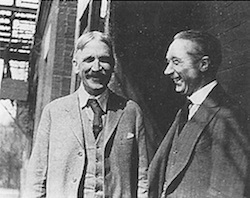

The American philosopher and educator John Dewey (1859-1952) first met F. Matthias Alexander at the time of the first World War and was deeply impressed by the practical benefits and scientific soundness of his teaching. Dewey had individual lessons in the Alexander Technique over a 35-year period and wrote the introductions to three of Alexander's books. He readily acknowledged that he owed the “concrete” form of certain of his ideas to his experience of the Alexander Technique. Basic among these ideas was a thorough-going acceptance of the principle of mind-body unity, which Dewey—like Alexander—believed was the “missing link” in the current theories of both physiologists and psychologists.
F.M. Alexander and the Alexander Technique
F. Matthias Alexander (1869-1955) was the developer of the education system known as the Alexander Technique, originally developed as a method of vocal and breathing improvement. Through extensive practical observation and experience, Alexander realized that coordination of the vocal and breathing mechanisms was an intrinsic part of the coordination of the body as a whole and that this functioning of the body should not be seen and treated as separate from mental activity.
 |
| Photo © 2010 The Society of Teachers of the Alexander Technique, London |
| John Dewey (left) with F. M. Alexander |
Interference with natural and efficient coordination is caused by faulty habits. Alexander found that most people's sensory feedback mechanisms become skewed by long-term inefficient habits. What may “feel” correct or natural may be quite “incorrect” and unnecessarily stressful. This inaccurate sensory feedback cannot be relied on for efficient overall functioning or to effect constructive change in basic faulty habits of coordination. Alexander observed that healthy coordination is based on an intrinsic dynamic relationship of the head, neck, torso, and limbs. In an Alexander Technique lesson, a student learns to consciously reduce or stop habitual interference with this natural relationship. The teacher uses his hands and verbal instruction to guide the student through fundamental, mechanically advantageous movements in a non-habitual, healthier and more natural manner. These non-habitual kinesthetic experiences are repeated and expanded upon many times. The repeated lessening of habitual and stressful interference brings about improvement in overall coordination. This improvement in general coordination includes increased reliablity of sensory appreciation, which results in more proficiency in all activities, as all activities are based on sensory appreciation/feedback whether they are “thinking” or “doing” activities.
Habits are “end-gaining” in nature; a habitual response
consists of immediately taking action to achieve a certain end
without first stopping to consider the most efficient means to
that end. In an Alexander Technique lesson, a student is taken
through, and thus learns, the psychophysical experience of
stopping inefficient “movement/postural” habits. “Stopping” a
habit consists of “inhibition”—refusing to make an immediate,
habitual response to a stimulus, and then considering and
following through on the “means-whereby” a better response can be
made while continuing to inhibit (refuse to make) the habitual
response. This technique for stopping a habit can be applied to
any habit whether it is so-called “mental” or “physical.” Alexander emphasized that all “mental” and “physical” habits and
activities are psychophysical. Alexander first taught his
technique in the 1890s and continued to develop it for the rest of
his life. He practiced mostly in London and also taught at
intervals in the United States.
© 1997 Marian Goldberg
For more information on the Alexander Technique, see Alexander Technique: The Insiders' Guide.
The Alexander Technique
“Mr. Alexander has done a service to the
subject by insistently treating each act as involving the whole
integrated individual, the whole psycho-physical man. To take a
step is an affair, not of this limb or that limb solely, but of
the total neuromuscular activity of the moment--not the least of
the head and the neck.”
Charles
Sherrington
Nobel Laureate in Physiology/Medicine
“Between the three of us [Tinbergen, wife, and daughter] we already notice with growing amazement, very striking improvements in such diverse things as high blood pressure, breathing, depth of sleep, overall cheerfulness and mental alertness, resilience against outside pressures, and also in such a refined skill as playing a stringed instrument.”
Nikolaas
Tinbergen
Nobel Laureate in Physiology/Medicine
“As one goes on, new areas are opened, new possibilities are seen and realized; one finds himself continually growing, and realizes that there is an endless process of growth initiated.”
John Dewey
Learning the Alexander Technique
Return
to:
Top of page
John Dewey and the Alexander Technique Index
Alexander Technique: The Insiders’ Guide
John Dewey and the Alexander Technique
Website created 1997 by Marian Goldberg
Website maintained by Marian Goldberg
Alexander Technique: The Insiders’ Guide
Website created and maintained by Marian Goldberg
Alexander Technique Center of Washington, D.C.
info@alexandercenter.com